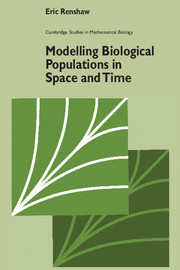Book contents
- Frontmatter
- Contents
- Dedication
- Preface
- A list of symbols and notation
- 1 Introductory remarks
- 2 Simple birth–death processes
- 3 General birth–death processes
- 4 Time-lag models of population growth
- 5 Competition processes
- 6 Predator–prey processes
- 7 Spatial predator–prey systems
- 8 Fluctuating environments
- 9 Spatial population dynamics
- 10 Epidemic processes
- 11 Linear and branching architectures
- References
- Author index
- Subject index
3 - General birth–death processes
Published online by Cambridge University Press: 05 August 2012
- Frontmatter
- Contents
- Dedication
- Preface
- A list of symbols and notation
- 1 Introductory remarks
- 2 Simple birth–death processes
- 3 General birth–death processes
- 4 Time-lag models of population growth
- 5 Competition processes
- 6 Predator–prey processes
- 7 Spatial predator–prey systems
- 8 Fluctuating environments
- 9 Spatial population dynamics
- 10 Epidemic processes
- 11 Linear and branching architectures
- References
- Author index
- Subject index
Summary
The simple birth–death process is developed under the assumption that the probabilities that an organism will reproduce or die remain constant and are independent of population size. Obviously this can only be true if there is no interference amongst individual population members. However, in a restricted environment the growth of any expanding population must eventually be limited by a shortage of resources. A stage is then reached when the demands made on these resources preclude further growth and the population is then at its saturation level, a value determined by the ‘carrying capacity’ of the environment.
It might appear that this implies that a large number of separate theoretical models have to be analyzed, each one corresponding to a different type of interference between individual organisms competing for available resources. Fortunately this is not the case, as we can often take advantage of the fact that the total number of individuals (N) in a fixed region of space can change for only four reasons, namely:
(a) birth – rate depends on N
(b) death (N > 0) – rate depends on N
(c) immigration – rate independent of N
(d) emigration (N > 0) – rate independent of N.
Indeed, if we combine (a) and (c) to form a general birth rate B(N), and (b) and (d) to form a general death rate D(N), then between them B(N) and D(N) encompass any modelling situation for which the population size N changes by one unit at each event. For example, in the simple immigration–birth–death process (Section 2.4) B(N) = α + λN and D(N) = µN.
- Type
- Chapter
- Information
- Modelling Biological Populations in Space and Time , pp. 46 - 86Publisher: Cambridge University PressPrint publication year: 1991
- 1
- Cited by

